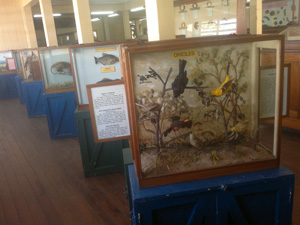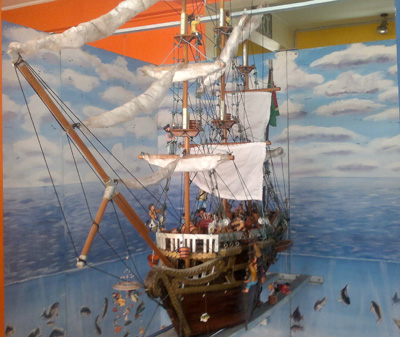Moves afoot to develop social history collection
By Telesha Ramnarine
FOCUS will soon be placed on developing the social history collections of the Guyana National Museum to make it more reflective of Guyanese heritage.

The institution, which sees some 200 visitors per week, started out as a natural history museum.
“Since Guyana does not have a social history museum, so to speak, we have to play the role of that. For many years, the focus would have been on the natural history collections, but now there’s an actual need to develop social history,” Administrator Tamika Boatswain told the Guyana Chronicle recently.
Speaking at her office inside the museum at Company Path, in Georgetown, Boatswain explained that there is also going to be some development in the natural history collections. “We will look at bringing in more specimens that we don’t have, or that needs to be replaced,” she said, adding:

“So, hopefully in the future, you might see permanent exhibits on indentureship, fishing, slavery, etc., that will help to teach about the social and political history of Guyana.”
EXCITING
Currently, the most exciting exhibit at the museum, based on the public’s feedback, is the Mega T Room which features a giant sloth. “A lot of visitors are fascinated with its size. It was a real sloth found in Germany’s interior that was brought here,” Boatswain, who works along with 15 other staff members, informed.
The museum, Guyana’s oldest, has been facilitating an active school loan programme in which small cases belonging to the arts center are taken to various schools and left for a period of two weeks.
The information found on the cases all relate to the science curriculum and thus schools have an opportunity to incorporate them into their lessons. “We do this for as many schools as possible in

Linden, East Coast, East Bank and around Georgetown. We will start introducing worksheets and so forth to introduce students to critical thinking in science to help them better understand what they are seeing,” Boatswain explained.
This arrangement will resume in January after schools would have been reopened.
Cleaning remains a gigantic task at the museum. “In order to keep on top of cleaning, you have to do it on a daily or weekly basis. We are always cleaning. We are always trying to take care of the collections as much as we can. That’s the only way we can preserve them.”
CLEANING

Cleaning is especially challenging because of the museum’s location in the busy streets of the City. Furthermore, the windows are all opened during the day. “The animals require specific conditions because the growth of fungus can develop and cause damage to the artifact. A lot of our collections have been here for more than 40 years and to maintain animal skins for so long takes a lot of care,” said Boatswain.
Most of what is available at the museum today have been from local donations, although quite a number have been given from different parts of the world.
BRIEF HISTORY
The story of the museum is one of tragedy, loss and recovery. After the establishment of the Royal Agricultural and Commercial Society in 1844, one of its main projects was the establishment of a museum and model room to display Guyana’s natural heritage.
The first recorded gift to the museum was a donation of 50 wood samples from Sir Robert Schomburgk. The collection gradually increased as donations of botanicals, minerals and other geological specimens were received.
Fire destroyed this first collection in 1864 and through the initiative of Mr. W.H. Campbell, a new collection was reassembled in 1868 when the museum had its first official opening.
A second fire, in 1945, demolished the natural history section of the museum and a new collection was again reassembled in 1946.
The British Guiana Museum changed to the Guyana National Museum upon the country’s independence in 1966. The collection today is divided into social and natural history sections with an exotic display of native birds, mammals and woods.
The social history exhibits include the model of the Royal Agriculture and Commercial Society, models of Fort Nassau and Zeelandia, the SS Arawana and Queriman ferry models, the Gold and Diamond Miner/Pork Knocker, the recreation of gold mining in the Cuyuni River, the Black on Magenta One Cent Stamp which is the world’s rarest stamp, the Dutch slave whip, a collection of antique bottles, several tobacco smoking pipes and the Chinese opium pipes.
Along with the natural history collection of mammals, birds, reptiles and fishes, other exhibits in this section include insects, illustrations of the seed and how germination takes place in plants, fruits, rice and different types of leaves. Also on display are various kinds of woods which are homogenous to Guyana and include wallaba, purple heart, green heart, crabwood and silverbali.
Visits are free to the museum. Opening hours are Monday to Friday 9 am to 4: 30 pm and Saturday 9 am to 2: 30 pm.












